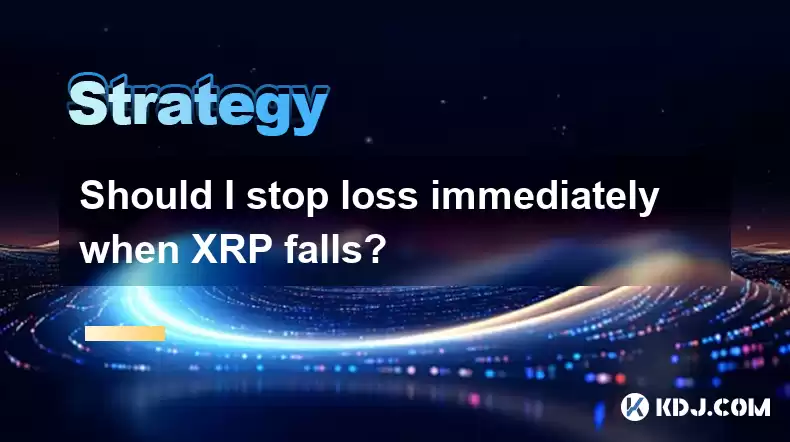-
 Bitcoin
Bitcoin $115200
1.46% -
 Ethereum
Ethereum $3672
2.95% -
 XRP
XRP $3.004
1.51% -
 Tether USDt
Tether USDt $1.000
0.04% -
 BNB
BNB $772.6
3.15% -
 Solana
Solana $168.2
3.14% -
 USDC
USDC $0.9998
-0.01% -
 TRON
TRON $0.3365
1.44% -
 Dogecoin
Dogecoin $0.2053
3.66% -
 Cardano
Cardano $0.7414
2.80% -
 Hyperliquid
Hyperliquid $38.30
0.43% -
 Stellar
Stellar $0.3983
0.73% -
 Sui
Sui $3.496
3.19% -
 Bitcoin Cash
Bitcoin Cash $571.4
4.49% -
 Chainlink
Chainlink $16.75
2.91% -
 Hedera
Hedera $0.2440
2.21% -
 Ethena USDe
Ethena USDe $1.001
0.03% -
 Avalanche
Avalanche $22.18
2.14% -
 Litecoin
Litecoin $120.6
0.40% -
 UNUS SED LEO
UNUS SED LEO $8.991
0.05% -
 Toncoin
Toncoin $3.229
-0.62% -
 Shiba Inu
Shiba Inu $0.00001234
3.28% -
 Uniswap
Uniswap $9.757
3.45% -
 Polkadot
Polkadot $3.666
2.22% -
 Dai
Dai $1.000
0.01% -
 Monero
Monero $282.3
-4.49% -
 Bitget Token
Bitget Token $4.360
1.80% -
 Cronos
Cronos $0.1437
6.19% -
 Pepe
Pepe $0.00001050
4.21% -
 Aave
Aave $263.0
4.02%
Should I stop loss immediately when XRP falls?
When XRP falls, consider market volatility, investment goals, and risk tolerance before setting an immediate stop loss to avoid selling during temporary dips.
Apr 20, 2025 at 12:21 pm

When considering whether to implement a stop loss immediately when XRP falls, it's crucial to understand the intricacies of stop loss orders and the specific dynamics of XRP as a cryptocurrency. Stop loss orders are designed to limit an investor's loss on a position in a security. For XRP, or any cryptocurrency, deciding to use a stop loss involves several factors, including market volatility, personal investment strategy, and the current market conditions.
Understanding Stop Loss Orders
A stop loss order is an order placed with a broker to buy or sell once the stock reaches a certain price. A stop loss is designed to limit an investor's loss on a security position. For XRP, setting a stop loss can help protect your investment from significant downturns. However, the effectiveness of a stop loss depends on the volatility of the market. Cryptocurrencies like XRP are known for their high volatility, which can lead to rapid price changes.
The Volatility of XRP
XRP, like many cryptocurrencies, experiences significant price swings. These fluctuations can be due to various factors such as market sentiment, regulatory news, or technological developments. Understanding the volatility of XRP is crucial when deciding whether to implement a stop loss immediately. If the market is particularly volatile, a stop loss might be triggered too soon, potentially leading to a sale at a lower price than desired.
Factors to Consider Before Setting a Stop Loss
Before deciding to set a stop loss immediately when XRP falls, consider the following factors:
- Market Conditions: Assess the current market environment. Are there any significant news events or regulatory changes affecting XRP?
- Investment Goals: What are your investment goals? Are you looking for short-term gains, or are you in it for the long haul?
- Risk Tolerance: How much risk are you willing to take? If you have a low risk tolerance, you might want to set a stop loss sooner.
How to Set a Stop Loss for XRP
If you decide that setting a stop loss is the right move for your XRP investment, here's how you can do it:
- Choose a Brokerage Platform: Ensure your chosen platform supports stop loss orders for cryptocurrencies.
- Determine Your Stop Loss Price: Decide at what price you want to trigger the stop loss. This could be a percentage drop from your purchase price or a specific price point.
- Place the Order: On your trading platform, navigate to the order section, select 'Stop Loss', and enter your desired stop loss price. Confirm the order.
Potential Drawbacks of Immediate Stop Loss
While stop losses can protect against significant losses, they also have potential drawbacks. An immediate stop loss might lead to selling XRP during a temporary dip, only for the price to recover shortly after. This can result in missed opportunities for gains. Additionally, during periods of high volatility, there's a risk of slippage, where the stop loss order is executed at a worse price than intended.
Alternatives to Immediate Stop Loss
Instead of setting an immediate stop loss when XRP falls, consider these alternatives:
- Trailing Stop Loss: This type of stop loss adjusts with the market price, allowing you to secure profits while still protecting against significant losses.
- Periodic Review: Regularly review your XRP investment and adjust your strategy based on current market conditions and your investment goals.
- Diversification: Spread your investments across different assets to mitigate risk, reducing the need for immediate stop losses.
Implementing a Thoughtful Strategy
Implementing a thoughtful strategy for managing your XRP investments involves more than just setting a stop loss. Consider your overall investment strategy and how XRP fits into it. Are you using XRP as a speculative investment, or do you believe in its long-term potential? Your strategy should align with your investment goals and risk tolerance.
Monitoring and Adjusting Your Stop Loss
If you do decide to use a stop loss for your XRP investment, it's important to monitor and adjust it as needed. Market conditions can change rapidly, and what was a suitable stop loss price one day might not be appropriate the next. Regularly review your stop loss settings and adjust them based on the latest market trends and your investment strategy.
Frequently Asked Questions
Q: How does the volatility of XRP affect the effectiveness of a stop loss?
A: The high volatility of XRP can lead to rapid price changes, which may cause a stop loss to be triggered too soon. This can result in selling XRP at a lower price than intended, especially during temporary market dips.
Q: Can a stop loss guarantee that I won't lose more than a certain amount on XRP?
A: No, a stop loss cannot guarantee a specific loss amount due to the potential for slippage during volatile market conditions. The actual execution price may differ from the stop loss price set.
Q: Should I set a stop loss based on a percentage drop or a specific price point for XRP?
A: Both methods have their merits. Setting a stop loss based on a percentage drop can help maintain a consistent risk management strategy across different investments. However, setting it at a specific price point might be more suitable if you have a clear target in mind based on technical analysis or market conditions.
Q: Are there any tools or indicators that can help me decide when to set a stop loss for XRP?
A: Yes, several technical indicators can assist in setting a stop loss for XRP. Tools like moving averages, Bollinger Bands, and the Relative Strength Index (RSI) can provide insights into market trends and volatility, helping you make more informed decisions about stop loss placement.
Disclaimer:info@kdj.com
The information provided is not trading advice. kdj.com does not assume any responsibility for any investments made based on the information provided in this article. Cryptocurrencies are highly volatile and it is highly recommended that you invest with caution after thorough research!
If you believe that the content used on this website infringes your copyright, please contact us immediately (info@kdj.com) and we will delete it promptly.
- OZAK AI: Is This AI Product Poised for ChatGPT-Level Returns?
- 2025-08-07 03:30:13
- SEC, Liquid Staking, and Crypto: A New Dawn?
- 2025-08-07 03:30:13
- Bitcoin, Ozak AI, and Crypto Veterans: A New York Minute on What's Hot
- 2025-08-07 02:31:03
- KakaoBank Eyes Stablecoin Market: A New Era for Digital Assets in South Korea?
- 2025-08-07 02:31:03
- Ethereum's Scaling Saga: Gas Limits, Leadership, and the Road to 100M
- 2025-08-07 02:50:40
- Bitcoin Income Evolution: Decoding YBTC and the Future of Crypto Yield
- 2025-08-07 02:50:40
Related knowledge

How to avoid common crypto investment mistakes?
Jul 13,2025 at 01:35am
Understanding the Risks of Crypto InvestmentInvesting in cryptocurrency can be highly rewarding, but it also comes with significant risks. One of the ...

What is a long-short crypto strategy?
Jul 15,2025 at 10:56am
Understanding the Basics of a Long-Short Crypto StrategyA long-short crypto strategy is an investment approach where traders simultaneously take long ...

What is a long-short crypto strategy?
Jul 11,2025 at 01:28pm
Understanding the Basics of Long-Short Crypto StrategyA long-short crypto strategy is an investment approach where traders take both long and short po...

How to use the RSI indicator for crypto?
Jul 12,2025 at 03:56pm
Understanding the RSI Indicator in Cryptocurrency TradingThe Relative Strength Index (RSI) is a momentum oscillator used to measure the speed and chan...

Is copy trading a good strategy for crypto beginners?
Jul 12,2025 at 08:28am
Understanding Copy Trading in the Cryptocurrency MarketCopy trading is a strategy where novice traders replicate the trades of experienced investors a...

How to build a crypto portfolio with $1000?
Jul 13,2025 at 08:14pm
Understanding the Basics of Cryptocurrency InvestmentBuilding a crypto portfolio with $1000 starts with understanding the fundamentals of cryptocurren...

How to avoid common crypto investment mistakes?
Jul 13,2025 at 01:35am
Understanding the Risks of Crypto InvestmentInvesting in cryptocurrency can be highly rewarding, but it also comes with significant risks. One of the ...

What is a long-short crypto strategy?
Jul 15,2025 at 10:56am
Understanding the Basics of a Long-Short Crypto StrategyA long-short crypto strategy is an investment approach where traders simultaneously take long ...

What is a long-short crypto strategy?
Jul 11,2025 at 01:28pm
Understanding the Basics of Long-Short Crypto StrategyA long-short crypto strategy is an investment approach where traders take both long and short po...

How to use the RSI indicator for crypto?
Jul 12,2025 at 03:56pm
Understanding the RSI Indicator in Cryptocurrency TradingThe Relative Strength Index (RSI) is a momentum oscillator used to measure the speed and chan...

Is copy trading a good strategy for crypto beginners?
Jul 12,2025 at 08:28am
Understanding Copy Trading in the Cryptocurrency MarketCopy trading is a strategy where novice traders replicate the trades of experienced investors a...

How to build a crypto portfolio with $1000?
Jul 13,2025 at 08:14pm
Understanding the Basics of Cryptocurrency InvestmentBuilding a crypto portfolio with $1000 starts with understanding the fundamentals of cryptocurren...
See all articles

























































































